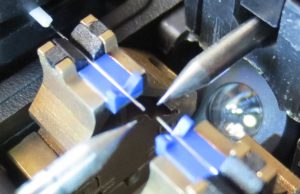 In 1970, the innovation of optical fiber entered the telecommunications scene. Fusion splicing shortly followed as the most reliable means of permanently joining two optical fibers via electric arc. This technology creates a continuous optical path for signal transmission and provides the strongest connection with the lowest loss and reflectance of all fiber termination methods, with splices typically measuring less than 0.1dB of loss.
In 1970, the innovation of optical fiber entered the telecommunications scene. Fusion splicing shortly followed as the most reliable means of permanently joining two optical fibers via electric arc. This technology creates a continuous optical path for signal transmission and provides the strongest connection with the lowest loss and reflectance of all fiber termination methods, with splices typically measuring less than 0.1dB of loss.
Fortunately, what was once an expensive and labor-intensive process with heavy, cumbersome equipment has significantly evolved. Several improvements in fusion splicing technologies now make it easier to invest in what has become an increasingly popular fiber termination method to meet today’s increasing network demands.
Consider the following tips:
1. Only Use Active Clad Alignment for Same-Era Fiber
Fiber consists of a central core, cladding that surrounds the core, and a protective coating. A singlemode fiber has a coating that typically measures 250 microns, a cladding of 125 microns, and a core of 8 microns. An active clad alignment splicer aligns the outer edges of the cladding by holding the fibers in a v-groove using electrodes as they move along an x- and y-axis, using cameras to assist with analyzing the alignment. Clad alignment is not recommended when splicing modern-day fiber with previous generations of fiber. Over time, fiber manufacturers have succeeded in improving fiber geometry, and the core concentricity will likely differ. When fiber cores are not the same concentricity, alignment can be off and the signal will not have an optimum path, resulting in a signal loss at the splice location, degrading or preventing transmission.
 2. Achieve Greater Accuracy with Core Alignment
2. Achieve Greater Accuracy with Core Alignment
Instead of focusing on aligning the outer edges of the fiber’s cladding, core alignment promotes light moving uninterrupted through the fiber core based on its properties. For example, because light moves differently through the core than the cladding, it glows brighter at the core. Core alignment solutions provide greater accuracy when splicing single fibers, especially when splicing two fibers that may not have the same core concentricity.
3. Choose a Mass Fusion Splicer for Ribbon Fiber
With increasing bandwidth demands, fiber counts have increased. To fit more fibers into a small footprint, manufacturers use ribbon fiber where 12 color-coded fibers are grouped together. A fiber cable can contain multiple tubes packed with ribbon fibers, arranged either flat and stacked or rolled, enabling fiber counts in a single cable to reach as high as 6912! Mass fusion splicers should be used for splicing ribbon fiber as they allow all 12 fibers to be fused simultaneously, significantly saving time and money. These splicers use clad alignment technology with multiple v-grooves to align all 12 fibers, but advancements in mass fusion splicing have increased accuracy closer to that of core alignment solutions.
4. Embrace the Variety of Applications
To meet bandwidth demands and high-speed application loss requirements, fusion splicing has significantly grown in popularity. The industry has catapulted away from simple cable-to-cable splicing long employed for restoration and repairs in outside plant single-mode applications to now encompass a diverse application portfolio across a multitude of environments.
 Cable-to-pigtail splicing has become increasingly popular in inside-plant applications for repairs, adds, moves, or changes. Used with both single- and multimode fiber and either single or ribbon fiber, pigtail splicing has become the de facto choice for terminating incoming outside plant fiber to indoor fiber at the building entrance or demarcation point with splices typically residing in the rack- or wall-mounted enclosures. Depending on the type of fiber, core or active clad alignment solutions are both effective for pigtail splicing.
Cable-to-pigtail splicing has become increasingly popular in inside-plant applications for repairs, adds, moves, or changes. Used with both single- and multimode fiber and either single or ribbon fiber, pigtail splicing has become the de facto choice for terminating incoming outside plant fiber to indoor fiber at the building entrance or demarcation point with splices typically residing in the rack- or wall-mounted enclosures. Depending on the type of fiber, core or active clad alignment solutions are both effective for pigtail splicing.
Also used in inside-plant applications, splice-on connectors have become increasingly popular for use with both singlemode and multimode fiber, and either single or ribbon fiber. They offer a reliable, low-loss method for easily terminating tight-buffered indoor fiber to single-fiber, duplex-fiber, or multi-fiber connectors.
5. Easily Justify Your Investment
Early fusion splicing equipment was expensive and cumbersome, costing anywhere from $12K to $40K and weighing an average of 30 pounds. Fusion splicing was also labor intensive, often requiring a team of two or three people to manually splice in a protected environment, qualify with an OTDR, and oversee the process.
Today’s splicing equipment is far less expensive, ranging between $4K and $18K, depending on the application and features. They can be easily run by one employee, feature intuitive touchscreen interfaces, and are highly portable with splicers from Sumitomo Electric and UCL Swift weighing less than 5 pounds. Fusion splicers have also advanced to deliver a very close loss estimation during the splicing process and incorporate a pull test after the fibers are fused, eliminating the need for continuous testing during the splicing process. Per industry standards, it is however recommended to test the overall end-to-end loss of the link once splicing is complete. With its ability to support growing bandwidth demand and enable higher transmission speeds, the number of applications requiring fiber is on the rise. Manufacturers are working to make fiber optic cables easier to install, repair, and update. At the same time, the cost of electronics and splicing technologies continues to drop. Fusion splicing is now crucial for contractors to meet the network demands of today. Thankfully advancements in fusion splicing technology make justifying the investment easier than ever.
